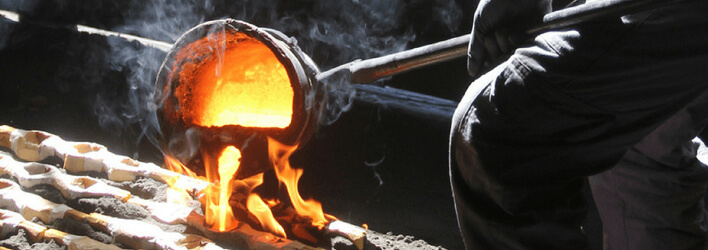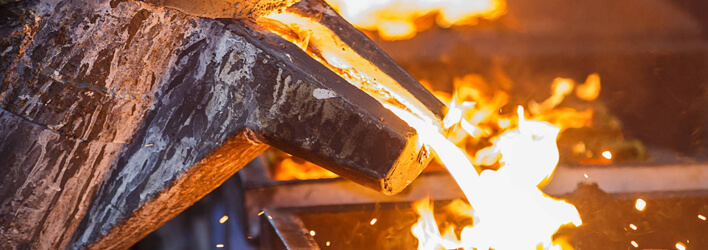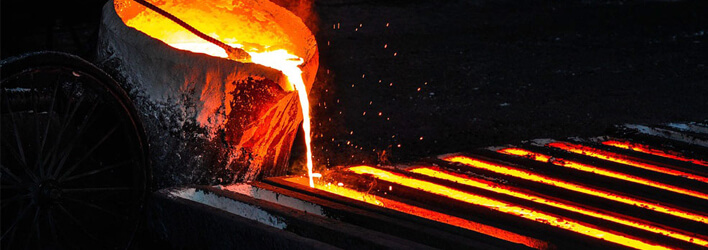What Is Metal Casting?

The complex process of metal casting requires precise chemistry and flawless execution. The first casting of metals dates back to 4000 BC. and the first metal to be cast was gold because of its malleability. Later bronze and copper became the metal of choice to cast. Thus, the modern and advanced process of casting carries ancient roots. So, what exactly is metal casting, and what is the need to cast the metals?
Metal casting is used to make different metal objects in various shapes. Complex metal shapes can be created by pouring the hot molten metal into a mold of the desired shape, and once the metal gets cool, it is extracted from the mold. Different metals in various shapes are much needed in varied industries such as automotive parts, pedals for the school bus, wheels for train, etc.
There are precise steps and methods used to cast metals. The patterns made of wood, metal, plastic, or plaster is designed with exact calculations. For hollow casting, an additional piece of metals is used to form the core. Molding is a multistep process and requires careful handling.
The final casted metal product is carefully removed and cleaned for further use. The metal casting process can create complex shapes and large components. We can cast some metal parts that are difficult to make to get the desired complex shape. Casting is cheaper than other manufacturing processes to prepare large quantities of the metal product.
What are the different types of Casting Process?

Today, the casting process has become a lot more advanced and sophisticated. The modern methods often use a computerized automated design process and involve different casting process.
Sand Casting
Sand casting is the simplest and most popular type of casting. It allows the manufacturers to create casted metal products at a very reasonable cost. The Sand-casting process may need just a few days or doesn’t get over in weeks. The small-size operations can accommodate most metals to be cast, and they can recycle the sand used many times.
Investment Casting
Investment casting has been practiced for many centuries now and is also known as lost-wax casting. It is one of the oldest metal casting techniques. Today, high technology waxes, specialist alloys, and refractory materials are used to create high-quality components. They know the investment casting procedure offers higher accuracy and versatility. However, one has to work carefully with the wax patterns that are not strong enough to endure mold making forces.
Die Casting
They make the die castings from nonferrous metals such as zinc, copper, and aluminum, but it is possible to work with ferrous metal. They force the molten metal to mold cavities under high pressure in the die casting method, and the process is more suitable for medium-sized parts that require dimensional consistency and fine surface quality. A hot- or cold-chamber machine is used based on the metal being cast. What limits the die casting process is the large capital costs.
Low-pressure Casting
Low pressure casting systems are based upon pressurization levels and can be categorized as unsealed, sealed, and vacuum-assisted. A pressurized furnace with typical pressures around 0.7 bar is used to fill the die with metal, and the pressure holds the metal in the die until it is solidified. The main advantage is the resulting quality of the molten metal is very high. The low-pressure filling systems satisfy the obligation of avoiding the bubbles in the metal.
Centrifugal Casting
The centrifugal casting process involves pouring the molten metal into the rotating mold. As they pour the metal into the mold, they push the molten metal toward the periphery for the inertial fIt relies on its own force, it is gravity and pressure independent. The casting process is useful for working with viscous liquid metals difficult to work with.
There is a practical limit for semi- and true-centrifugal processing. One of the early applications of the Centrifugal casting method was the casting of railway wheels.
Gravity Die Casting
Gravity die casting was developed for metal, and light alloy die casting. It is a very ancient process where the molten metal is directly poured into a semi-permanent or permanent die. The objective behind is to minimize porosity and fill the die with the least turbulence. It produces high-quality castings with dense mechanical strength. One can plan automated production for high-volume with a minimum investment.
Vacuum Die Casting
It takes advantage of a good vacuum in the mold cavity and allows the alloy to flow into complicated recesses to create complex shapes. As the molten metal moves and merges freely because of the vacuum, that has a greater density and tensile strength. Thus, one can create thinner and more complex castings of greater density and strength with reduced porosity.
Vacuum supplements, a well-designed casting process, along with good vacuum, ensure an excellent surface quality. The vacuum die-casted materials find many applications in the automotive industry and commercial, industrial sectors.
Squeezing Die Casting
Squeezing die casting is a blend of casting and forging process that results in a cast product with impressive mechanical properties. Where the molten metal is poured into a preheated die, and the upper half of the die applies pressure as the metal starts solidifying. It is possible to achieve finer details because of the high pressure and the close contact of molten alloy.
What you get is a final product with minimum porosity. The squeeze casting process can be direct or indirect. Squeeze casting is simple, convenient, and economical procure and finds extensive application in the automotive sector.
What Products are made by Casting?

It is crucial to have a reliable manufacturer and supplier for your industry needs. Maipu Machinery is one such name that you can count on and trust. It has developed into a manufacturing expert with precision casting and produces multiple manufacturing parts of various industries like forging, welding, mining, construction machinery, agriculture, railroad, medical, food processing, and oil & gas industry.
What Advantages of the Casting Services offered by Maple?
They produce and export castings to Europe and North America. Primarily steel castings and iron castings.
Top-notch quality products are manufactured and the professional services appreciated by customers.
Excellent manufacturing service network that signs a long-term cooperation agreement with electroplating plants and heat treatment plants.
They ace in the manufacturing of welded parts and stamping parts.
Maple has excelled in steel manufacturing industry and provide their customers with varied choices.
They have customers across 30 countries, over 40 industries and still growing.

